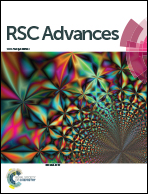High surface area TiO2 nanoparticles by a freeze-drying approach for dye-sensitized solar cells
Abstract
We outline a simple protocol for fabricating high surface area (∼86 m2 g−1) TiO2 nanoparticles via freeze-drying of a composite of a TiO2 precursor ((Ti(IV) isopropoxide)) and a polymer (polyester) solution. The composite upon freeze-drying results in a porous mass which on subsequent sintering results in degradation of the polymer and formation of TiO2 nanoparticles. The TiO2 particles when employed as a photoanode of dye-sensitized solar cells show an efficiency (η) of ∼7%.


 Please wait while we load your content...
Please wait while we load your content...